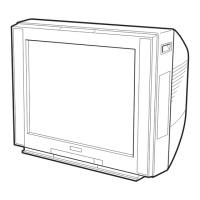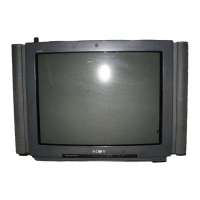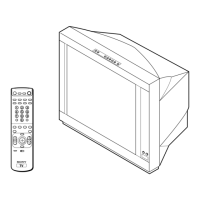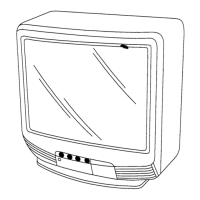Do you have a question about the Sony KV-EF34M31 and is the answer not in the manual?
Describes error codes, symptoms, probable causes, and detected symptoms for TV malfunctions.
Explains the meaning of different STANDBY/TIMER lamp flash counts indicating specific problems.
Instructions on how to display, clear, and manage self-diagnostic results on the TV screen.
Details the internal circuits and conditions that trigger self-diagnostic error codes.
Initial setup steps including connecting antenna, VCR, and inserting remote batteries.
Guides for connecting external audio/video devices like camcorders, DVD players, and game equipment.
Instructions on how to secure the TV to prevent falling and basic safety precautions.
Steps for turning on the TV, selecting channels using the remote, and adjusting volume.
Instructions on accessing the menu system and changing the display language.
How to select different picture and sound modes for optimal viewing and listening.
Setting the wake-up timer to turn the TV on and the sleep timer to turn it off.
Viewing and setting preferred channels for quick access.
Displaying multiple video sources simultaneously using Picture-in-Picture or TWIN features.
Navigating through preset TV programs and video inputs using an index screen.
Selecting surround sound effects and stereo/bilingual audio programs.
Accessing Teletext information services and using FASTEXT for quick page selection.
Using the remote control to operate connected Sony video equipment like VCRs and DVD players.
Detailed guide on how to use the TV's menu system for various settings.
Adjusting picture and sound parameters like mode, contrast, brightness, and surround.
Configuring Picture-in-Picture (PIP), TWIN pictures, and PROGRAM INDEX features.
System configurations including language, channel blocking, picture rotation, and volume adjustment.
Blocking specific channels using CHILD LOCK and setting up favorite channels.
Procedures for automatic and manual channel preset, including skipping channels.
A guide to diagnosing and resolving common TV problems like noisy sound or distorted pictures.
Quick checks for antenna connection and AC connection issues to resolve viewing problems.
Explanation of the TV's self-diagnosis feature and how to interpret error indicators.
Locating and understanding the function of TV front panel buttons and remote controls.
Steps for removing the rear panel and speaker assembly for access.
Procedures for removing the main chassis and various electronic boards (D1, DH, J1, V1, P, A, B).
Steps for removing the demagnetization coil, H1 board, and top switch assembly.
Detailed procedure for safely removing the picture tube from the TV chassis.
Aligning electron beams and correcting color convergence for picture purity and alignment.
Ensuring picture sharpness and adjusting the neck assembly twist for optimal display.
Setting the G2 (screen) voltage and adjusting white balance for accurate color reproduction.
Procedures for entering, cancelling, writing, and confirming adjustments in service mode.
Detailed adjustments for sub color, sub hue, Y level, H-Trapizoid, and frequency.
Specific steps for adjusting the A Board after replacing the memory IC.
Correcting geometric picture distortions such as H/V position, size, and trapezoid.
High-level block diagrams and detailed frame schematic diagrams of the TV's circuits.
Visual guides showing the location and layout of main circuit boards like A, B, and C.
Detailed schematic diagrams and waveforms for various boards (A, B, P, D2, J1, H1, F, DH, VM2, C, B4, V1).
List and images of various semiconductor components used in the TV's circuitry.
A visual breakdown of the picture tube assembly and its associated components.
A visual breakdown of the main chassis components and their assembly order.
Detailed list of electrical components for Board B, including part numbers and descriptions.
Detailed list of electrical components for Board A, including part numbers and descriptions.
Detailed list of electrical components for Board P, including part numbers and descriptions.
Detailed list of electrical components for Board V1, including part numbers and descriptions.
Detailed lists of electrical components for Boards D2, DH, and H1.
Detailed list of electrical components for Board J1, including part numbers and descriptions.
Describes error codes, symptoms, probable causes, and detected symptoms for TV malfunctions.
Explains the meaning of different STANDBY/TIMER lamp flash counts indicating specific problems.
Instructions on how to display, clear, and manage self-diagnostic results on the TV screen.
Details the internal circuits and conditions that trigger self-diagnostic error codes.
Initial setup steps including connecting antenna, VCR, and inserting remote batteries.
Guides for connecting external audio/video devices like camcorders, DVD players, and game equipment.
Instructions on how to secure the TV to prevent falling and basic safety precautions.
Steps for turning on the TV, selecting channels using the remote, and adjusting volume.
Instructions on accessing the menu system and changing the display language.
How to select different picture and sound modes for optimal viewing and listening.
Setting the wake-up timer to turn the TV on and the sleep timer to turn it off.
Viewing and setting preferred channels for quick access.
Displaying multiple video sources simultaneously using Picture-in-Picture or TWIN features.
Navigating through preset TV programs and video inputs using an index screen.
Selecting surround sound effects and stereo/bilingual audio programs.
Accessing Teletext information services and using FASTEXT for quick page selection.
Using the remote control to operate connected Sony video equipment like VCRs and DVD players.
Detailed guide on how to use the TV's menu system for various settings.
Adjusting picture and sound parameters like mode, contrast, brightness, and surround.
Configuring Picture-in-Picture (PIP), TWIN pictures, and PROGRAM INDEX features.
System configurations including language, channel blocking, picture rotation, and volume adjustment.
Blocking specific channels using CHILD LOCK and setting up favorite channels.
Procedures for automatic and manual channel preset, including skipping channels.
A guide to diagnosing and resolving common TV problems like noisy sound or distorted pictures.
Quick checks for antenna connection and AC connection issues to resolve viewing problems.
Explanation of the TV's self-diagnosis feature and how to interpret error indicators.
Locating and understanding the function of TV front panel buttons and remote controls.
Steps for removing the rear panel and speaker assembly for access.
Procedures for removing the main chassis and various electronic boards (D1, DH, J1, V1, P, A, B).
Steps for removing the demagnetization coil, H1 board, and top switch assembly.
Detailed procedure for safely removing the picture tube from the TV chassis.
Aligning electron beams and correcting color convergence for picture purity and alignment.
Ensuring picture sharpness and adjusting the neck assembly twist for optimal display.
Setting the G2 (screen) voltage and adjusting white balance for accurate color reproduction.
Procedures for entering, cancelling, writing, and confirming adjustments in service mode.
Detailed adjustments for sub color, sub hue, Y level, H-Trapizoid, and frequency.
Specific steps for adjusting the A Board after replacing the memory IC.
Correcting geometric picture distortions such as H/V position, size, and trapezoid.
High-level block diagrams and detailed frame schematic diagrams of the TV's circuits.
Visual guides showing the location and layout of main circuit boards like A, B, and C.
Detailed schematic diagrams and waveforms for various boards (A, B, P, D2, J1, H1, F, DH, VM2, C, B4, V1).
List and images of various semiconductor components used in the TV's circuitry.
A visual breakdown of the picture tube assembly and its associated components.
A visual breakdown of the main chassis components and their assembly order.
Detailed list of electrical components for Board B, including part numbers and descriptions.
Detailed list of electrical components for Board A, including part numbers and descriptions.
Detailed list of electrical components for Board P, including part numbers and descriptions.
Detailed list of electrical components for Board V1, including part numbers and descriptions.
Detailed lists of electrical components for Boards D2, DH, and H1.
Detailed list of electrical components for Board J1, including part numbers and descriptions.












